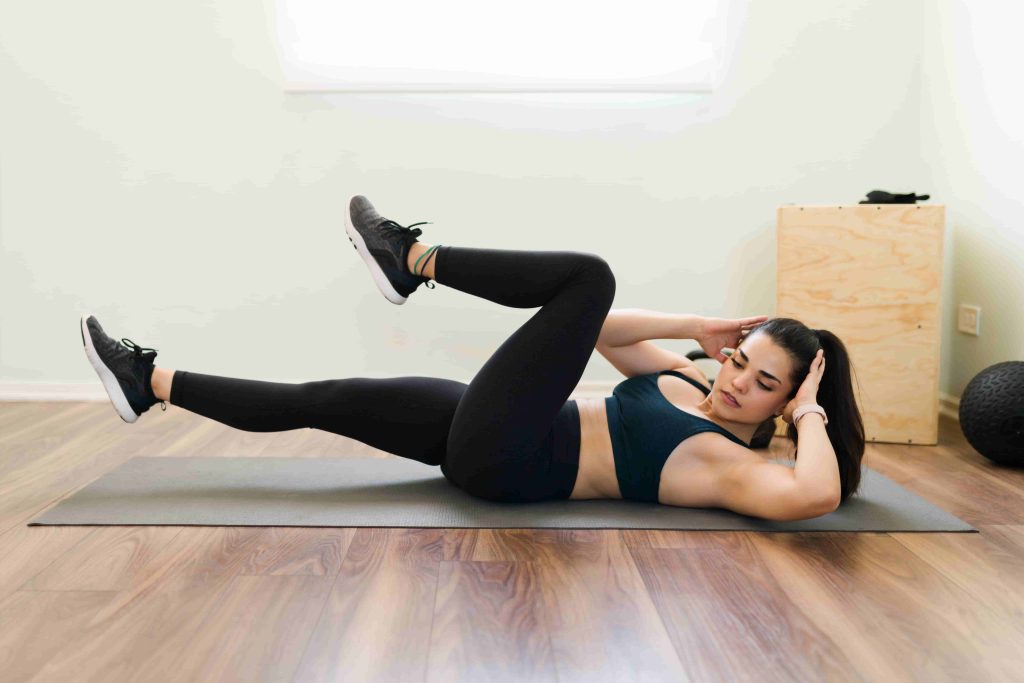5 de August de 2025
Supine Cycling: Exercise Guide, Tips and Benefits
Supine cycling—also known as recumbent or lying-down cycling—is a low-impact, joint-friendly cardiovascular exercise that targets the lower body while placing minimal stress on the back and knees. Whether performed on a recumbent bike or as part of core-focused training, supine cycling is an excellent option for improving endurance, activating the core, and promoting fat loss.
In this guide, we’ll explain how to do it properly, what muscles it works, common mistakes to avoid, and how to include it in a strength and conditioning (S&C) program.
What Is Supine Cycling?
Supine cycling refers to a pedaling motion done from a reclined position. It’s commonly performed using a recumbent exercise bike or mimicked on the floor through a supine bicycle crunch. The body lies back while the legs rotate or extend in a cycling motion, activating the hip flexors, core, and quads.
This variation is especially useful for rehabilitation, core training, and low-impact cardio routines. Athletes may use it during recovery phases or to train endurance with reduced spinal load.

How to Do Supine Cycling Properly
On a Recumbent Bike
- Sit back in the seat with your back fully supported.
- Adjust the seat so your legs are slightly bent at full extension.
- Grip the side handles and engage your core.
- Pedal with consistent rhythm, maintaining a moderate cadence.
Floor-Based Bicycle Crunch (Supine Bicycle)
- Lie on your back with your hands behind your head and knees bent.
- Lift your shoulders and legs off the ground.
- Extend one leg while bringing the opposite knee toward your chest.
- Twist your torso so your elbow moves toward the bent knee.
- Alternate sides in a pedaling motion.
Muscles Worked by Supine Cycling
Supine cycling activates several key muscle groups:
- Quadriceps and Hamstrings: Main drivers of the pedaling motion
- Hip Flexors: Heavily involved in leg lift and cycling
- Glutes: Engaged with increased resistance or incline
- Core (Rectus Abdominis & Obliques): Especially in floor variations
- Calves: Assist in ankle movement during rotation
By engaging both the upper and lower abdominals, supine cycling offers a great core-strengthening option that complements traditional endurance training.
Benefits of Supine Cycling
- Low Impact on Joints: Ideal for individuals with knee or back limitations
- Improves Cardiovascular Endurance: Supports aerobic development in a safe position
- Core Strength Development: Especially with floor-based variations
- Rehabilitation-Friendly: Useful for athletes recovering from lower-body injuries
- Fat Loss Support: Can help increase energy expenditure as part of a broader plan
To better manage fatigue during training cycles, learn more about how to monitor and reduce fatigue for long-term performance gains.
Common Mistakes to Avoid
- Poor Seat Adjustment (Bike): Incorrect positioning may reduce effectiveness or cause joint stress.
- Overarching the Back (Floor): Always keep your lower back in contact with the ground to avoid strain.
- Rushed Repetitions: Fast, sloppy form reduces engagement and increases injury risk.
- Neglecting Breathing: Coordinate breathing with the movement to maintain rhythm and core engagement.
- Lack of Progression: Failing to increase resistance or duration can lead to plateaus.
Check out our guide on strength and conditioning principles for tips on progressive overload and long-term adaptation.

Variations of Supine Cycling
- Weighted Bicycle Crunch: Hold a light plate or med ball to increase resistance
- Tempo-Based Supine Cycling: Slow down each repetition for time under tension
- Interval Supine Cycling: Alternate between fast and slow pedaling phases (on bike)
- Mini-Band Bicycle Kicks: Add a resistance band around the feet for extra challenge
These variations can be integrated into core circuits, cardio sessions, or active recovery days.
How to Include Supine Cycling in Your S&C Workout
- Warm-Up: Use recumbent bike cycling for 5–10 minutes to prepare joints and boost circulation.
- Core Circuit: Add floor-based supine cycling in sets of 30–45 seconds between strength exercises.
- Recovery Days: Include 15–30 minutes of low-resistance recumbent cycling for aerobic base building.
- Conditioning: Use high-resistance intervals on a recumbent bike to target endurance and lactate threshold.
Supine cycling fits well into all levels of athletic preparation and complements strength work without adding excessive load.
FAQs About Supine Cycling
How to do a supine bicycle?
Lie on your back, lift your legs and shoulders, and alternate bringing your knees and opposite elbows together in a pedaling motion.
Does lying down cycling reduce belly fat?
It can aid fat loss as part of a calorie-controlled program, but spot reduction isn’t possible—whole-body fat loss is key.
Supine cycling is more than just an alternative cardio option—it’s a strategic tool for recovery, endurance, and core development. Use it wisely within a broader S&C framework and pair it with progressive strength and mobility work to enhance athletic performance sustainably.
